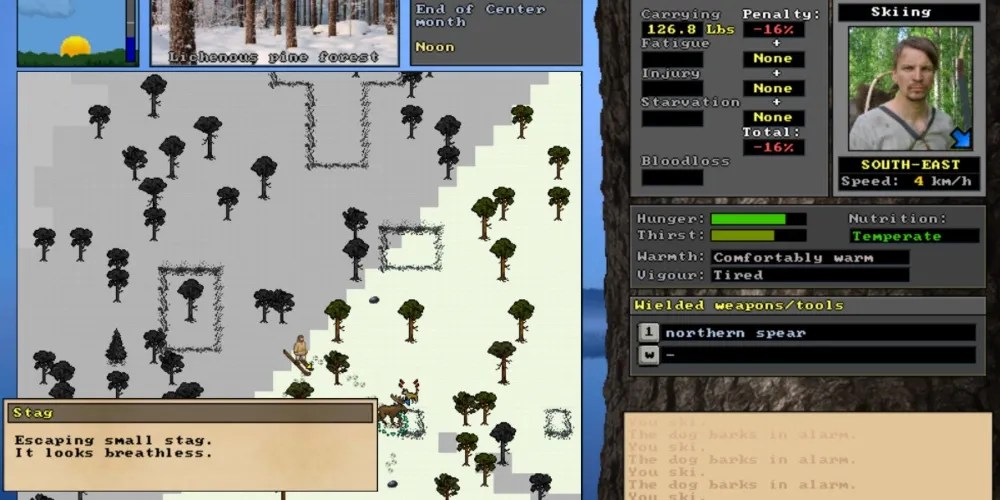Modern gaming is a very different beast than it was before the turn of the millennium. A constantly-online world, powered by social media, pervades all of our activities, including games, while advances in technology let our favorite medium go bigger and try new things.
Or do they? Ideas don’t just come in a vacuum, and you might be surprised to learn that some of the things that we see as hallmarks of gaming in the 2020s have been around for quite a while… just not with all the flashy media blitzes and livestreams to show them off.

8Open Worlds
Players love being able to explore, and big open worlds where secrets could be hiding around every corner always get lots of attention. While modern tech has made our digital playgrounds bigger and more expansive than ever before, developers have been giving us the opportunity to search and strive at our own pace almost since the beginning.
TheUltimaseries, which started on PC in 1981, dropped players into a fantasy world and gave them their quest, then turned them loose to complete it however they could in traditional turn-based manner. On consoles,The Legend Of Zelda(1986) did largely the same thing with puzzles and real-time combat.

7Choices That Matter
Games have put us through some truly agonizing decisions in the last year or so, mixing moral quandries with the cold, hard calculus of how your choices will affect the outcome of the story. Should you release the Rachni Queen? How should you deal with the Nether Brain? Which faction should you join?
It’s tough to pick out classic games where impactful decisions were an intended feature. Text-based adventures likeZorkandKing’s Questgave you plenty of freedom to do what you wanted, and consequences to match, but that’s hardly the kind of branching storyline that we know and stress over today. By the ’90s, though, CRPGs likeFallout(1994) were giving players the chance to really shape the world with their actions.

6Leaderboards
The more competitive among you might be dedicated to climbing the leaderboards in your favorite game, while others probably don’t give them a second thought. Of course, ranking players based on their overall performance is nothing new; games have been doing it since the days of the arcade.
Space Invaders(1978) maintained a leaderboard rather than just tracking the highest score that had yet been achieved on an individual machine, making it the first of its kind in gaming. Even pinball machines wouldn’t incorporate this feature until 1985, when Gottlieb put high scores ina Chicago Cubs-branded cabinet.

5Pay-To-Win
Speaking of arcades, no discussion of modern gaming and its antecedents is complete without talking about the pitfalls as well. In our world of gacha games and microtransactions, online games always run the risk of replacing player skill with deep enough pockets.
Burning through a roll of quarters to see the credits roll onthe classic X-Men, Simpsons, or Teenage Mutant Ninja Turtlesarcade cabinetsmay not have the same financial impact as racking up credit card bills pulling the newest gacha banner, but it still speaks to the same design principle; with the odds stacked against you this much, even skilled players will probably need to fork over some cash.

4VR Headsets
Just over a decade ago, the Oculus Rift was an ambitious, risky project that might finally make home virtual reality possible. It was a dream that hardware designers had been chasing for ages, and as we know now, it paid off. PSVR, Meta Quest, and other VR headsets are right at home with traditional consoles and PCs.
While the earliest VR headsets can be traced back to the 1960s, where devices patented with names like “Telesphere Mask” could project simple wireframe rooms, virtual reality as we know it wasn’t feasible until much later. Gadgets like theVPL Datasuitin the ’80s gave way to the infamous Power Glove, and while Sega tried to make a home VR set in 1991, they ultimately decided it wasa better fit for arcades.

“Nobody wants to watch somebody else play video games.”
-My mom, circa 1992.
Esports have become a global phenomenon, and while they haven’t yet cracked the code of how to compete with traditional sports, it’s questionable whether they actually need to. With legions of dedicated fans and opportunities for exciting spectacles at live events or viewed from home, they’ve become a cultural touchstone of the 21st century.
Of course, there have been organized video game tournaments as long as there have been video games, just without all the fanfare. The rise of (mostly) balanced competitive games likeStreet FighterandQuakein the ’90s gave rise to larger events, but even before that there was the legendaryNintendo World Championshipwith its gold cartridge as a prize - now a holy grail for retro collectors.

The earliest recorded video game tournament took place atStanford University in 1972, where 1v1 matches of Spacewar comprised theIntergalactic Spacewar Olympics. According to thisarchived article, the event offered free beer, and the grand prize was a year’s subscription to Rolling Stone Magazine.
2MMOs
While they’re not as monolithic as they were in the heyday ofWorld Of Warcraft, massively-multiplayer online games are still very much alive and well, both in traditional RPGs and in new platforms likeRoblox.
WoW wasn’t the first MMO by a long shot, having followed in the footsteps ofEverQuest(1999),Ultima Online(1997) ,Meridian 59(1996), andThe Realm Online(1996) - to name a few.Neverwinter Nightscollaborated with America OnLine to create aD&Dgame world for players to inhabit in 1991, and before thatmulti-user dungeons(MUDs) used ASCII graphics and text inputs to connect players - though this was usually in smaller groups over a LAN.
However, 1985’sIsland of Kesmaiwas available through the CompuServe network, making it effectively thefirst commercial MMO.This was still the early days of the Internet, though, so only about 100 players could be online at a time. Given how few people had Internet access, though, it was successful enough that the game continued until 1999, when it wassold to EA, who shut it down the next year.
1Survival Crafting
From kid-friendly ventures likeMinecraftto gritty survivalist fantasies likeRust, there’s no genre that quite symbolizes the 2010s and 2020s like theopen-world survival crafting game.
Okay, maybe the Soulslike too, but the point is, survival crafting is a big deal.
Survival crafting existed in gamesas early as 1994, but you’d be forgiven for not having heard of it until the genre got big. Games likeRobinson’s Requiemwere very niche and were much slower and clunkier than we’re used to now, due to the limitations of the era.
The true original open-world survival crafter, though, isUnReal World.It was released in 1992 as a fantasy roguelike, but in 1996 received an update that introducedsurvival mechanics like starvation, crafting, and shelter.Perhaps even more impressive is thatUnReal World is still active and being supported to this day,with no signs of slowing down; its most recent update as of this writing was on July 01, 2025.